IN THIS ISSUE
- Conserving a living prairie relic
- Fewer hummingbirds? July will help tell
- Fungus behind bat-killing disease moves south
- Animal encounters: cottonmouths, crow vs. osprey
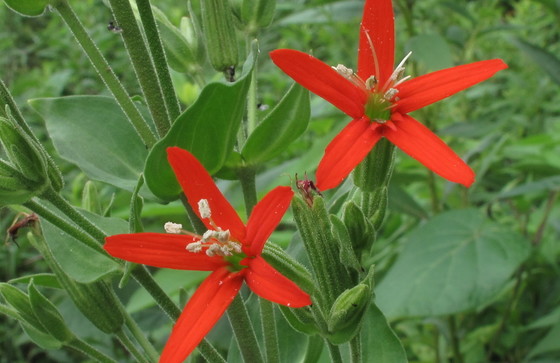 Royal catchfly in bloom (Alan Cressler)
By MELANIE FLOOD
Royal catchfly, listed as a state-endangered plant in Georgia, is a native of the Midwest’s tallgrass prairies.
But wait, we don’t have prairies in Georgia, do we? Not the sweeping ones of the Midwest, but we do have prairie remnants. Patches are frequently found on roadsides in areas that still contain native grasses and wildflowers, such as the royal catchly (Silene regia), with its beautiful red petals and tall stature.
For the past two years, I’ve worked as a Georgia Plant Conservation Alliance botanical guardian with botanist Tom Govus and partners including Georgia Power, the Southeast Lineman Training Center, Georgia Forestry Commission, the Georgia Department of Transportation and volunteers to improve a population of royal catchfly on a utility right of way in northwest Georgia.
The site had about 60 of the rare plants in 2018. After efforts including bush-hogging, cutting back woody vegetation and conducting a prescribed burn, there are now more than 100!
This project demonstrates the importance of working with partners such as Georgia Power and DOT to protect native plant species in right of ways. It also shows that with dedication and consistency, anything is possible – even restoring part of Georgia’s botanical history.
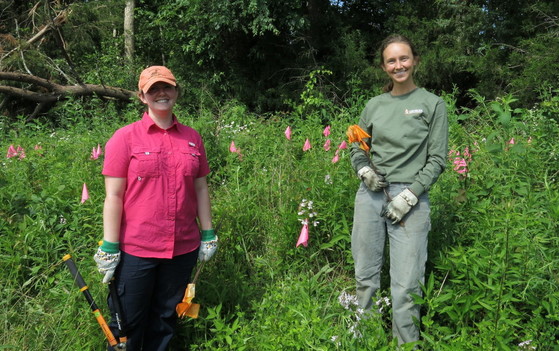 GPCA volunteers Sara Smith, left, and Melanie Flood flagged royal catchfly last month. (DNR)
Top
 Ruby-throated hummingbirds crowd a feeder (Terry W. Johnson)
By TERRY W. JOHNSON
As far as many Georgia hummingbird fanciers are concerned, 2020 has been a disappointment.
It seems that throughout spring and early summer, they have seen far fewer ruby-throated hummingbirds than expected. The apparent lack of these popular flying jewels has spawned concern that the number of ruby-throats has plummeted.
Some are worried that weather or a lack of food led to widespread mortality during winter. Others wonder if our warm, wet spring resulted in hummers migrating through Georgia faster than normal.
I’m not aware that biologists have detected a significant decline in ruby-throats. But if so, July is the month we should know. Here’s why. …
Read the rest of Terry’s column for more on the annual hummer surge, and how to estimate the number visiting your yard.
Also: DNR has added his columns to the Wildlife Resources Division blog. Look for them under the Conservation tab.
Terry W. Johnson is a retired DNR program manager and executive director of TERN, the Wildlife Conservation Section’s friends group. Check out past columns, his Backyard Wildlife Connection blog and his book “A Journey of Discovery: Monroe County Outdoors.” Permission is required to reprint his column.
Top
 While not surprised, scientists are concerned at finding the fungus responsible for white-nose syndrome in culverts in the Georgia Piedmont this winter.
The spread south of Pseudogymnoascus destructans from the north Georgia mountains and the fungus’ appearance in road and drainage culverts are both firsts for the state, according to a recent Department of Natural Resources report on white-nose surveys. Carroll, Clarke and Monroe also are the only additional counties to test positive for Pd since 2015.
Katrina Morris, a senior wildlife biologist with DNR's Wildlife Conservation Section, stressed that documenting the fungus in the Piedmont doesn’t mean white-nose will soon follow.
"We don’t know how that’s going to play out,” Morris said.
But all agree the discovery highlights a key concern:
That the disease which has killed millions of bats in North America will spread from north Georgia caves – where it has decimated some bat populations since 2013 – through the cave-scarce Piedmont via transportation structures bats use for roosting, and then into south Georgia caves.
For the latest on white-nose surveys, see DNR’s report and interactive map.
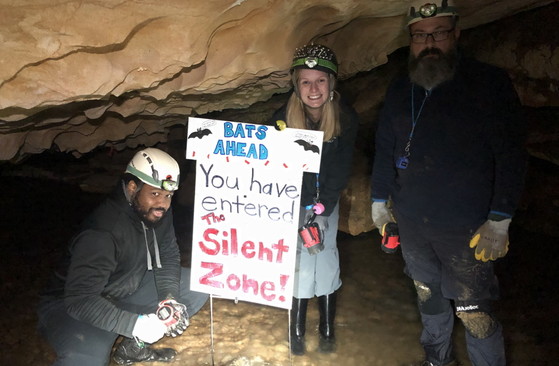 DNR staff and volunteers during a cave survey for white-nose syndrome (DNR)
WHAT YOU CAN DO
- Learn more at georgiawildlife.com/wns and whitenosesyndrome.org.
- Report bat die-offs or bats possibly suffering from white-nose by emailing GaDNRBats@dnr.ga.gov.
- Support conservation of Georgia’s bats and other native wildlife and natural habitats. DNR’s Wildlife Conservation Section depends largely on public support. Much of that funding comes from sales and annual renewals of the bald eagle, monarch butterfly and ruby-throated hummingbird license plates, as well as from direct donations, including online.
Top
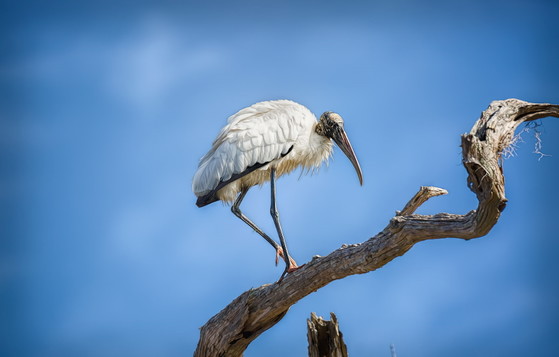 Wood stork at Stephen C. Foster State Park (Alicia Pastiran/Georgia Nature Photographers Association)
Legislation to conserve wildlife and wildlands is on the move in Congress. The Senate passed the Great American Outdoors Act (S. 3422), which would permanently fund the Land and Water Conservation Fund and cover a $9.5 billion maintenance backlog on public lands such as national parks and forests. A House vote is expected next week. Also in the House, representatives OK’d amendments to an economic stimulus package that includes Recovering America’s Wildlife Act. The act would help states and tribal wildlife agencies conserve more than 12,000 species at risk of becoming threatened or endangered – an annual $1.4 billion investment that would return an estimated economic impact of nearly $3.4 billion.
The Georgia Legislature, reconvening in June after suspending its session for the pandemic, designated shoal bass as the state’s riverine sport fish and recognized the 50th anniversary of the Coastal Marshland Protection Act. (Related video: DNR’s Coastal Resources Division christened its new research vessel the Reid W. Harris, honoring the late St. Simons Island lawmaker who sponsored the marshland act).
Owning, importing or breeding tegus and green iguanas in Florida is now limited primarily to organizations with permits for education, research, eradication or control involving the non-native lizards that are spreading in the wild in the Sunshine State. The changes grandfather in licensed breeders, and let people who owned the reptiles as pets before July 1 get a permit to keep them.
Top
 Adult eastern fence lizard (top); juvenile Argentine black and white tegu (Adobe Stock; tegu/Dustin Smith)
Trapping and research targeting Georgia’s only known wild population of tegus continues in Toombs and Tattnall counties. But with residents urged to report sightings, it’s worth noting that eastern fence lizards – a native, harmless species – are often misidentified as juvenile tegus, although as hatchlings Argentine black and white tegus have distinct green heads and are already usually larger than the longest eastern fence lizard. Learn more.
While the pandemic boosted interest in birding, it grounded the annual search for peregrine falcons nests among Atlanta high-rises. Office closures disrupted the network of falcon watchers that help pinpoint possible nesting peregrines, said DNR’s Dr. Bob Sargent, adding that no nests were found this year.
With sea turtle hatchlings emerging and egg-laying nearing an end, the Georgia Sea Turtle Cooperative has recorded more than 2,470 loggerhead nests, powering predictions for 2,600-2,800 nests this summer. That wouldn't match last year's record of 3,950, but it would be double the total when comprehensive monitoring began in 1989. Hatchlings emerge first on St. Simons. More updates.
Top
 A third-grader plants for pollinators at Portal Elementary (Linda May/DNR)
Wanted: Conservation Teacher of the Year candidates. DNR’s Wildlife Conservation Section and its friends group TERN is again offering a $1,000 grant to a Georgia third-, fourth- or fifth-grade educator who demonstrates exceptional energy and innovation in teaching life sciences. How to apply.
New rare-plant populations have been found on two middle Georgia wildlife management areas. DNR senior wildlife biologist Nathan Klaus reported shuttleworth ginger (Hexastylus shuttleworthii var. Harperii) at Sprewell Bluff and Florida senna (Chamaecrista deeringiana) at Sandhills WMA West, neither of which had been recorded on the WMAs.
Asked to explain this videoed meeting of an adult and a juvenile cottonmouth, DNR’s Matthew Moore called it “probably a chance encounter where they accidentally surprised each other.” Moore was focused on the adult – the same snake he videoed last spring with a juvenile on her back – and didn’t see the young one until it “dangled down into the upper left-hand corner of the (camera) view screen.”
Top
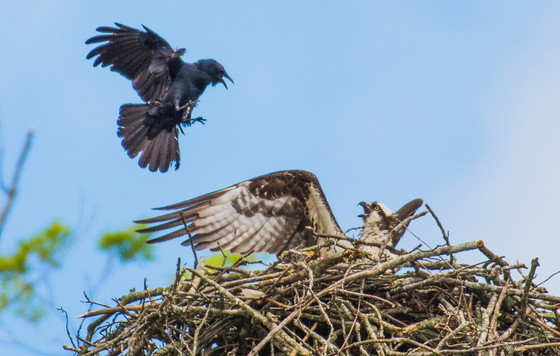 A fish crow harasses an osprey on the nest at Lake Allatoona (Ron Goldfarb)
More unique animal interactions: Photographer Ron Goldfarb caught this fish crow diving on a nesting osprey and its chick at Lake Allatoona. DNR’s Dr. Bob Sargent said the crow could have a nest nearby and wanted to scare the raptor away, or it might have been trying to drive the adult osprey off the nest so it could prey on the young or eggs.
Gone fishin’? Don’t miss out on the hot-weather action at DNR public fishing areas, one of summer’s best bites – catfishing – and the challenge and fun of pursuing a Georgia Bass Slam.
Although National Forest Week is winding down, it’s not also too late to schedule an adventure at a national forest (seven in 10 Americans live within a two-hour drive of one). Explore trip options at Georgia’s Chattahoochee-Oconee national forests using this interactive map.
Names in the news: Southern Co.'s Dr. Mark Berry has been named chair of the Georgia Conservancy’s Board of Trustees. Berry, vice president of Research and Development for Southern Co. and of Environment and Natural Resources for Georgia Power, succeeds former Chair Leslie Mattingly. The State Botanical Garden of Georgia’s conservation coordinator, Jennifer Ceska, is profiled as a Conservation Champion in the latest Center for Plant Conservation newsletter (scroll down for the Q&A with Ceska).
WHAT YOU MISSED ...
In the previous Georgia Wild:
- The wild promise of Ceylon
- What DNR's eagle nest survey found
- Hunting for flying leopards
- An electrofishing boat with a history
- Watch: bog work behind the scenes
Top
"Right whale calf first seen in Georgia killed by vessel strike," Savannah Morning News. Also: WABE-FM (90.1, Atlanta).
"Right whales on brink, Trump could be last hope," The New York Times
"Four right whale deaths last year caused by ship strikes," Canadian Broadcast Corp.
"DNR offers grant for top conservation teacher," Thomasville Times-Enterprise
"Buckhead riled about vultures; DNR says no need to worry," Rome News Tribune
"Sea turtles nesting at healthy rate," WSAV-TV (Ch. 3, Savannah)
"Georgia search for peregrine nests hobbled by pandemic," AllonGeorgia
"Tegus, green iguanas banned in Florida," The Arcadian (Arcadia, Fla.)
"Pythons spreading 'tongue worm' to native snakes," Palm Beach (Fla.) Post
"Horseshoe crab blood key to COVID vaccine, but ecosystem may suffer," National Geographic
(+video) "How flying snakes stay stable while gliding," Nature.com
"Georgia releases results of bald eagle survey," WRDW/WAGT-TV (chs. 12/26, Augusta). Also: Lakeside on Lanier.
"Humans pose threats to nesting shorebirds," The Albany Herald
"Castoff fishing line a menace to birds," Audubon.org
(+video) "Woman inspired to help protect manatees," WTOC-TV (Ch. 11, Savannah)
"Natural fires help native bees, improve food security," Phys.org (study in Ecology and Evolution)
"Kenya healing toxic relationship between vultures, people," BirdLife International
"Federal-state funding adds millions of acres for outdoor recreation," U.S. Fish and Wildlife Service
"Extreme route fish take by air to colonize new lakes," Sciencealert.com
Top
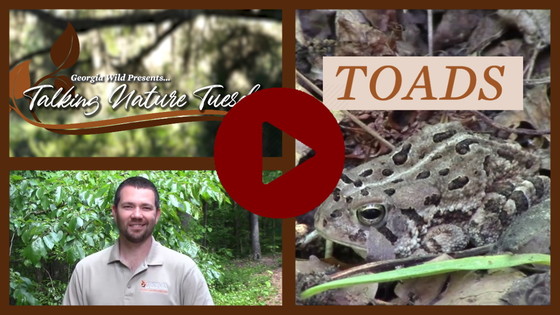 "Talking Nature Tuesday: toads," DNR Charlie Elliott Wildlife Center
"Georgia WMAs: everything you need to know to go," DNR
"Hey, whaddaya know? Vultures," DNR
"Juvenile osprey brings fresh catch to nest," Cornell Lab of Ornithology
"Waterfall safety," U.S. Forest Service
"Take an adult fishing," DNR
"Georgia Wild: hummingbirds," DNR
"Killmaster's Kitchen: smoked mackerel," DNR
"Operation Dry Water," U.S. Coast Guard
Top
 Right whale 3560 and her calf off Sapelo in December (Clearwater Marine Aquarium/NOAA permit 20556-01)
Another of the 10 North Atlantic right whales born this winter is gone. The calf's carcass was found floating off the New Jersey coast in late June. A necropsy documented propeller and other wounds indicating the young male had been hit at least twice by vessels. The most recent strike likely killed it, NOAA said. Vessel strikes and entanglement in commercial fishing gear are the leading threats to North Atlantic right whales. These whales, one of the world’s most endangered, calve off the Georgia/north Florida coast in winter. The calf that died last month was first spotted off Sapelo Island in December (watch DNR video of the young whale and its mom). The calf was then less than a week old, the first calf of the season and the first for right whale no. 3560. A second calf born this winter is presumed dead after suffering what looked like propeller injuries in January. Scientists estimate that right whales need 15-20 calves each season to sustain the species. Last week, the International Union for Conservation of Nature added North Atlantic right whales to its Red List, the last classification before extinction.
CREDITS
Masthead: a tri-colored bat in a Georgia cave (DNR)
Top
|